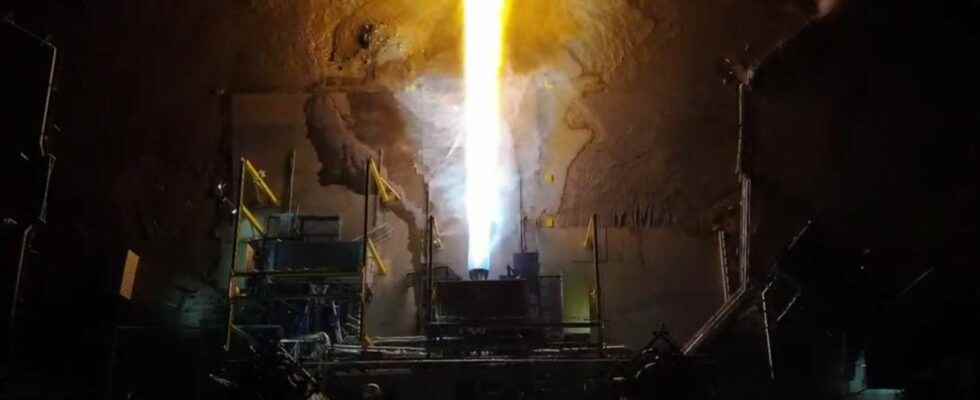Blue Origin, the aerospace company founded by Jeff Bezos, is developing the rocket engine named BE-4, which should equip its future New Glenn rocket and will be delivered to ULA for the Vulcan launcher. After several years of delay, the engine finally sees the end of the tunnel.
You will also be interested
[EN VIDÉO] Blue Origin: the future New Glenn launcher is unveiled on video Blue Origin has made public a new video, in computer generated images, which summarizes in less than two minutes the main characteristics and performances of New Glenn, its future launcher. Compared to the previous version, we learn that the upper stage and the headdress have been redesigned. The performance of the launcher, which will compete with Ariane 6 and Falcon 9 in commercial markets and Delta Heavy and Falcon 9 in US government markets, is the same. Only change, the main stage which was to be reusable a hundred times will be 25 times. First flight in 2021.
The force needed to pull 245 tonnes out of the ground is what Blue Origin’s new BE-4 engine should deliver. This beautiful power babe finds her strength in the combustion staged methane liquidwith an oxygen-rich pre-combustion, a rare technology, which until now was mastered only by the Soviets in their time, but which is making a comeback, especially in Europe.
A little methane and oxygen, the recipe for success
It should equip the launcher super heavy New Glennalso under development within the firm of Jeff Bezosbut it is also the subject of a contract with the company United Launch Alliance, born from the merger Between Boeing and Lockheed Martin. Indeed, BE-4 must equip the first stage with Vulcanthe launcher who succeeds the mythical Atlas V. This contract was carried out in 2014 to no longer depend on the Russian RD-180 engine, moreover the choice of methane is part of the current dynamics of the space sector.
Today two propellants are mainly used: kerosene (RP-1) and thehydrogen. The first delivers more force at the cost of the efficiency of the thrust generated, the second does the opposite. Liquid methane offers a very good compromise between the two, more efficient than kerosene, it remains simpler to produce than hydrogen with less complex engines, and therefore less expensive. L’ecological impact is also reduced compared to the RP-1, and at best, is equivalent to hydrogen rockets.
If the Vulcan is not intended to be fully reusable, the BE-4 can be detached and recovered to be reused at least 25 times.
An impressive test
Blue Origin posted this awesome video of the BE-4 on the test rig earlier this year. From the first seconds we can admire the surge of flames that we notice transparent. Again, this illustrates the compromise represented by methane: the flames of hydrogen are simply invisible, and those of kerosene are opaque.
You asked for video – we listened. Notable milestones for this #BE4 test included: ????Warm LOX/cold LNG start transient demonstration (bounding condition) ????First engine to eclipse 4000 seconds of accumulated hotfire test time, ultimately achieving 5000+ seconds. pic.twitter.com/pLbUEdrzqG
— Blue Origin (@blueorigin) May 11, 2022
We also note the presence of cones bluish in the heart of the flame, these are the Mach discs (or Mach diamonds), an overdensity caused by the dynamics of the fluids which is at work.
To the tune of ‘Lucy in the Sky with Diamonds’
Picture yourself with a rocket in a test stand
With propellent a loaded and sensors alive
Someone runs checklists
You count down quite slowly
And wait till the engine ignites
Watching rockets fire Mach diamonds…(repeat) pic.twitter.com/zfaenX8HHz— Scott Manley (@DJSnM) June 15, 2021
After four seconds, the flame widens, thickens and becomes more impressive, a sign of the passage to high speed of the turbopump which draws the fuel. The combustion is more intense, the pressure outlet gas is increased and equilibrates with the atmospheric pressure. Then the engine tilts thanks to its gimbal: cylinders which allow the thrust to be oriented (called vector thrust). In real conditions, the gimbal of rocket engines is a solution to generate torque, and thus rotate the rocket in theairor rather to keep it stably on the right trajectory.
Interested in what you just read?
